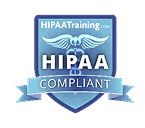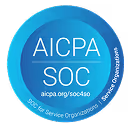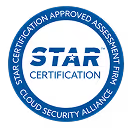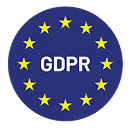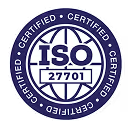Whether you're onboarding a new customer, implementing a complex project, or managing a difficult service delivery, you’re always managing risks. A risk is anything that could affect your project’s timeline, performance, or budget. Think of risks as “what-ifs.” If they happen, they turn into issues that need immediate attention.
Understanding how to identify, assess, and mitigate these risks can mean the difference between thriving and surviving. That’s where risk management comes in—it helps you identify, categorize, prioritize, and create action plans for risks before they escalate into bigger problems.
What is risk management?
Risk management is a system of processes, people, and tools to recognize, evaluate, and handle threats or risks that affect the finances, capital, and overall operations of your organization. The main goal of risk management is to predict possible risks and find solutions to deal with them successfully.
Whether it’s your team, budget, or tech stack, managing risks ensures you have the right resources at the right time to meet client expectations, hit deadlines, and maintain the quality your customers expect.
Risk management can take different forms depending on the project's size and scope. On large-scale projects, it may involve detailed planning and multiple mitigation strategies for every potential risk. A simple, prioritized list of high-, medium-, and low-priority risks might do the trick on smaller projects.
The risk management process typically includes three crucial steps:
- Risk identification: Potential risks are recognized and documented.
- Risk analysis and assessment: The likelihood and impact of identified risks are evaluated.
- Risk mitigation, management, and monitoring: Strategies are developed to minimize risks, with continuous oversight to ensure effective risk management.
Why is risk management important in professional services?
When it comes to services, you need to ensure that your team has the right skills, your budget is well-planned, and your technology can handle the evolving demands of your clients and projects. Here’s why risk management is critical in professional services:
- Prevents project disruptions: Whether it’s a key team member being unavailable or a delay in approvals, a lot can go wrong in customer-facing projects. A solid risk management plan helps you spot these issues early, allowing you to take proactive measures to keep things on track, even when unexpected challenges pop up.
- Protects your budget: Unplanned problems often lead to expensive, last-minute changes. Identifying risks early helps you avoid costly workarounds and stay within budget, addressing issues before they spiral out of control.
- Enhances decision-making: Anticipating potential risks gives you a clearer understanding of the hurdles you may face. This allows you to make smarter, more informed decisions about where to allocate resources and how to prioritize tasks, setting up your projects for continued success.
- Prioritizes critical focus areas: Not all risks are equal. Some are more likely to happen or could impact your project more. Effective risk management helps you rank these threats so you can focus on the most important ones, ensuring your efforts and resources are used wisely.
- Builds stakeholder confidence: When stakeholders see that you’ve considered potential risks and have plans to manage them, it builds trust. It shows that you’re prepared for challenges and committed to delivering results, which enhances your reputation with clients and partners.
- Builds and guards your reputation: Consistently delivering projects on time and within budget, despite potential risks, reinforces your business’s credibility. This boosts client satisfaction and positions you as a reliable, trusted partner in the long run.
Getting risk management right doesn’t just help you avoid problems; it also makes your business more efficient and resilient. The benefits of risk management include:
- Reducing downtime and resource shortages: Keep projects moving by ensuring critical resources are always available.
- Boosting overall productivity and efficiency: With fewer surprises, your team can focus on delivering quality work, leading to greater success in the long run.
- Ensures compliance: In industries governed by regulations like ASC, IFRS, and other compliance frameworks, risk management helps you meet necessary standards and avoid costly penalties. Having a clear risk strategy also shows clients that your business is committed to adhering to these regulations, further boosting credibility.
Key types of project risks
Project risks generally fall into two main categories: internal and external. Internal risks stem from within your organization—whether it’s resource availability, budget constraints, or capacity planning. External risks, on the other hand, come from outside forces like market changes, regulatory updates, or supply chain disruptions.
That being said, project risks come in many forms, and understanding the specific challenges under each category can help teams better anticipate and manage them. Here are the key types of risks to consider:
1. Operational risks
Operational risks relate to internal factors that affect the efficiency of a project’s workflow, resources, and team dynamics. These risks stem from issues that occur within the project’s environment, impacting how smoothly it operates.
- Workflow inefficiencies: Ineffective processes or unclear workflows can create bottlenecks, leading to delays and wasted resources.
- Lack of clarity: Unclear project objectives or vague roles and responsibilities can result in misaligned efforts and poor team performance.
- Communication breakdowns: Poor communication among team members can lead to misunderstandings and errors in project execution.
- Personnel changes: Changes in key personnel, such as team leads or subject matter experts, can disrupt progress and continuity.
- Resource shortages: Insufficient resources, such as budget, tools, or manpower, can prevent the project from moving forward as planned.
2. Strategic risks
Strategic risks arise when the project’s objectives become misaligned with the broader business goals, or when market and external forces change the project's direction. These risks are often linked to high-level planning and scope management.
- Changing business priorities: Shifts in organizational strategy or leadership can cause a project to lose relevance or become deprioritized.
- Scope creep: One of the most common strategic risks, scope creep occurs when project requirements or goals expand beyond the initial plan without adjustments to time or budget.
- Market shifts: External market forces, like competition or regulatory changes, can reduce the effectiveness of a project’s outcomes, leading to strategic misalignment.
- Unclear objectives: A lack of clear goals at the outset of the project can result in disjointed efforts, where the team is not aligned on the project's strategic direction.
3. Schedule risks
Schedule risks, or time risks, occur when the project’s timeline is disrupted due to unforeseen delays or miscalculations about the time certain tasks will take. These risks directly impact the ability to meet deadlines.
- Slow workflows: Inefficient processes or delays in completing tasks can extend the project timeline and impact deadlines.
- Underestimation of timelines: Misjudging how long tasks or milestones will take can create a domino effect, leading to missed deadlines.
- Dependencies on external parties: Relying on third-party vendors or other departments for critical deliverables can introduce delays beyond the team’s control.
- Time crunches: Projects can face schedule risks if they are over-ambitious or under-resourced, leading to a scramble to meet tight deadlines.
- Unplanned delays: Factors like unforeseen technical challenges or changes to project requirements can push schedules back significantly.
4. Financial risks
Financial risks occur when the project faces budget-related challenges. These risks are typically associated with poor budgeting, unexpected costs, or an overextension of resources.
- Over-budgeting: If the project’s cost exceeds the original budget estimate, it can lead to financial strain and reduced margins.
- Unplanned expenses: Additional costs incurred for, or extra resources, unexpected technology needs, or extended timelines, can quickly eat into a project’s budget.
- Inadequate cost forecasting: Poor planning and lack of detailed cost breakdowns during the budgeting phase can lead to underestimation and financial shortfalls.
- Funding constraints: Limitations on funding or resource allocation can inhibit the ability to deliver on project goals, particularly if scope or schedule changes mid-way.
5. Performance risks
Performance risks occur when a project fails to meet expected standards in terms of quality, efficiency, or outcomes. These risks are often tied to internal issues like skill gaps, poor team performance, or resource deficiencies.
- Low-quality deliverables: The project might not meet performance expectations due to team members' underperformance or technical limitations.
- Inadequate resources: Lack of access to the necessary tools, technology, or skills can lead to subpar performance and lower-quality outcomes.
- Miscommunication: Poor communication among team members or with stakeholders can result in misunderstandings, which can impact the overall quality of the project.
- Skill gaps: If team members lack the necessary expertise or training, the project may not be executed to the desired standards.
6. Technology and security risks
These risks emerge from the technological aspects of the project and are linked to the tools, platforms, and security measures employed to carry out the project. These include:
- Outdated or inefficient technology: Using outdated systems or tools can hinder the project’s efficiency and lead to technical failures.
- Cybersecurity threats: The risk of data breaches or hacking can compromise sensitive project information, especially in today’s digital landscape.
- Vendor management issues: Relying on third-party technology providers can introduce risks if vendors fail to deliver on time or provide adequate support.
- Compliance issues: Regulatory requirements, like ASC 606, IFRS, or industry-specific standards, can create risks if projects fail to meet legal obligations, leading to fines, project delays, or reputational damage.
A deep dive into the risk management process
At its core, effective risk management is an exercise in both foresight and precision. It's about anticipating challenges before they arise -- while ensuring you know exactly what to do to handle them. Here are the key components of such an approach:
1. Risk identification
Risk identification is the foundation of effective risk management, allowing you to recognize potential threats to your project's success. Start with a detailed project charter defining your vision, objectives, scope, and deliverables. This approach ensures risks are identified at every stage of the project.
Key techniques for effective risk identification:
- Brainstorming sessions: Engage cross-functional teams in collaborative discussions to uncover potential risks. Utilize platforms that support real-time collaboration and visual mapping for organized contributions.
- Stakeholder interviews: Conduct one-on-one or group interviews with internal team members and external partners. Pre-interview surveys can provide insights to shape discussions and identify less obvious risks.
- Checklists and historical data: Leverage pre-built risk checklists based on industry standards and analyze historical data from past projects to recognize recurring risks.
- SWOT analysis: Evaluate your organization’s strengths, weaknesses, opportunities, and threats. Use tools that help document and visualize these elements for easier risk categorization and prioritization.
Document all identified risks in a risk register, a central repository listing each risk along with its potential impact and associated mitigation strategies. Ensure your project management system allows for easy maintenance and updates of this register.
2. Risk assessment
Risk assessment involves analyzing and prioritizing identified risks based on their potential impact and likelihood of occurrence. This process can be divided into two main approaches:
- Qualitative risk assessment: Utilize a risk matrix to categorize risks based on their severity and likelihood. This matrix, with axes for probability and impact, helps visualize and prioritize risks needing immediate attention. Choose solutions that provide visual representations for structured risk analysis.
.webp)
- Quantitative risk assessment: This approach uses numerical data to evaluate risks. Look for functionalities that automate calculations of expected monetary value (EMV) for multiple risks, simplifying prioritization based on potential financial impact. Both methods yield insights into critical risks, enabling effective resource allocation.
3. Risk mitigation, management, and monitoring
After assessing risks, it’s essential to develop strategies for mitigation, management, and ongoing monitoring throughout the project lifecycle.
Mitigation strategies:
- Avoidance: Modify your project plan to eliminate risks. Seek capabilities that support agile adjustments to timelines and resources for flexibility.
- Reduction: Implement training programs to upskill your team, minimizing technical failures and enhancing overall project performance. Choose learning management systems that provide easy access to relevant training resources.
- Transfer: Use contract management capabilities to shift risk to third parties. Ensure your system manages contracts clearly and documents risk transfer agreements.
- Acceptance: Minor or unavoidable risks should be logged in your risk register and monitored with systems that offer easy tracking and visibility.
Monitoring and review: Risk monitoring is an ongoing process. Utilize your risk register to track each risk's status, noting whether it has been mitigated, escalated, or resolved. Include the following elements in your risk register:
- Risk ID: A unique identifier for the risk.
- Description: A brief description of the risk.
- Likelihood: Assessed probability of occurrence.
- Impact: Assessed severity of consequences.
- Risk owner: The person responsible for managing the risk.
- Mitigation strategy: Actions to address the risk.
- Status: Current state of the risk (e.g., active, resolved).
Choose solutions that allow for real-time updates and centralized access to your risk register, ensuring you have current information at all times.
The three pillars of risk management in professional services
In the professional services world, effective risk management is crucial for navigating uncertainties and ensuring sustainable growth. The three pillars of risk management—automation, visibility, and communication—provide a solid framework for identifying, assessing, and mitigating risks. Here’s how:
Automation
Automation plays a huge role in streamlining risk management processes, minimizing human error, and enhancing overall efficiency. Here's a closer look at its key contributions:
- Efficiency improvement: Automation tools can handle repetitive tasks such as data collection, risk assessment, and reporting. By automating these processes, professionals can redirect their efforts toward more strategic activities that add greater value to the organization. For instance, automated risk assessment tools can swiftly analyze large volumes of data to identify patterns and flag potential risks, saving both time and resources while ensuring that the information is current.
- Consistency and accuracy: Automated systems ensure that risk management protocols are applied uniformly across the organization. This consistency reduces the variability often associated with manual processes, leading to more accurate assessments and reports. Maintaining a standardized approach allows organizations to trust that their risk data reflects a true and comprehensive picture of potential challenges.
- Real-time monitoring: Automation provides organizations with real-time data analytics and monitoring of key risk indicators. This capability allows teams to respond quickly to emerging risks before they escalate. For example, automated dashboards can visualize critical risk metrics, alerting stakeholders to significant changes in the risk landscape. Decision-makers can act proactively rather than reactively by having this information readily available.
Visibility
Visibility in risk management is essential for informed decision-making and effective communication among stakeholders. Here are the crucial aspects of enhancing visibility:
- Data transparency: Increased visibility into risk data enables stakeholders to understand risks comprehensively and make informed decisions. This includes clear documentation of risk assessments, potential impacts, and the strategies in place for mitigation. Ensuring that risk data is accessible and transparent helps organizations foster a culture of openness that encourages proactive engagement with risks.
- Cross-functional insights: Integrating risk data across various departments allows organizations to gain a holistic view of risks. This cross-functional approach facilitates collaboration and joint decision-making. For example, finance, operations, and compliance teams can share insights and identify interdepartmental risks collectively, leading to more robust risk management strategies that address the interconnected nature of risks.
- Reporting and accountability: Enhanced visibility fosters accountability among team members. Clear reporting mechanisms ensure that everyone understands their roles in managing risks, which helps cultivate a culture of proactive risk management. Organizations can keep all stakeholders informed and engaged by establishing a framework for regular reporting on risk status and mitigation efforts.
Communication
Effective communication is crucial for ensuring that all stakeholders are aware of risks and the strategies in place to manage them. Here are the essential components of effective communication in risk management:
- Stakeholder engagement: Regular communication with stakeholders about risks, mitigation efforts, and outcomes is essential for building trust and ensuring alignment in understanding the organization’s risk profile. By keeping stakeholders informed through meetings, reports, and updates, organizations can encourage a shared commitment to managing risks effectively.
- Training and awareness: Ongoing training and awareness programs help teams understand risk management practices and their importance. These initiatives can include workshops, newsletters, and internal communications that highlight current risks and the strategies in place to mitigate them. Organizations empower their employees to be proactive in risk management by promoting a culture of continuous learning.
- Communication protocols for escalations: Establishing clear communication protocols for escalations is important to ensure that stakeholders are informed of significant risks and the responses being implemented. By defining the steps for escalating issues, organizations can ensure that all parties are on the same page, which can improve response efforts in high-pressure situations.
Incorporating these communication strategies into your risk management framework will not only improve team cohesion but also strengthen your organization's ability to navigate uncertainties and achieve its objectives, ultimately enhancing overall management resource effectiveness.
Key strategies for managing resource risks
Once risks have been identified, it's essential to address them proactively. Here are effective strategies for managing resource risks that can enhance resilience and performance:
Succession planning
Establishing robust backup plans for key roles is crucial to ensuring continuity within the organization. Organizations can minimize disruptions during personnel changes by identifying potential successors and preparing them through mentoring and training. This proactive approach ensures that critical knowledge and skills remain within the team, reducing the risk of operational setbacks.
Optimized resource allocation
Efficient resource allocation involves not just distributing resources wisely but also anticipating future needs. Regularly assessing resource availability and utilization helps organizations identify potential gaps and develop contingency plans to address shortfalls before they impact project timelines. This strategic foresight allows teams to remain agile and responsive to changing demands.
Analytics and technology
Leveraging advanced tools can significantly enhance resource risk management. Organizations should seek technologies that offer predictive analytics capabilities, allowing them to analyze historical data and forecast future resource needs. Additionally, automated monitoring features can help teams stay informed about resource usage in real time, enabling prompt action to mitigate risks before they escalate into larger issues. Here are key capabilities to look for
- Predictive analytics: Leveraging historical data to forecast future risks and their potential impacts. Organizations can proactively address emerging risks by identifying patterns and trends.
- Risk scoring models: Developing scoring systems that quantify risks based on various factors, including likelihood, impact, and detectability. This aids in prioritizing risks systematically.
- Dashboards and reporting: creating visual dashboards that provide real-time insights into the organization’s risk profile. This enables stakeholders to monitor key risk indicators (KRIs) and make informed decisions quickly.
Audits
Regular audits play a critical role in ensuring compliance and evaluating resource management practices. Internal audits provide organizations with a clear view of adherence to regulations and internal policies, while external audits offer an objective assessment of overall risk management. Both types of audits highlight areas for improvement, allowing organizations to take corrective action as needed and reinforcing a culture of accountability.
Resource monitoring and cost management
Regularly assessing resource usage is essential to prevent overload or underutilization, both of which can hinder performance. Implementing comprehensive monitoring processes allows organizations to optimize resource allocation continuously. Furthermore, maintaining strict financial oversight through careful planning and tracking ensures that project budgets remain aligned with strategic goals, preventing cost overruns.
Continuous learning and improvement
Fostering a culture of ongoing education is critical for keeping teams informed about best practices and emerging risks. Organizations should prioritize regular training sessions, workshops, and knowledge-sharing initiatives to equip employees with the skills needed to navigate the evolving landscape of resource management. By staying updated on new technologies and methodologies, teams can enhance their capability to identify and respond to risks effectively.
Tools that can help with risk management for professional services
Effective risk management is all about having the right tools and capabilities to streamline your processes, drive collaboration, and ensure timely visibility into every project. Here’s a closer look at essential resource management tools you should consider for optimizing your risk management efforts:
- Project management and professional services automation (PSA) software
When choosing software, prioritize solutions that include alerting and communication capabilities. Such tools simplify the risk assessment process, enabling teams to analyze and prioritize risks more effectively. With real-time tracking and centralized information sharing, all team members can access project materials instantly, ensuring everyone stays informed and aligned. This visibility allows for proactive monitoring of team progress and quick adjustments as needed. - Risk assessment and resource tracking software
These tools automate the identification and management of resource risks, allowing teams to focus on higher-level strategic decision-making. By providing visual dashboards and real-time analytics, these solutions help organizations stay ahead of potential challenges and facilitate data-driven decision-making. - Scenario planning and simulation tools
Scenario planning tools allow teams to test "what-if" scenarios to evaluate how various factors might impact resources. This proactive approach enables organizations to anticipate potential risks and develop effective risk mitigation strategies that can be quickly implemented if needed. - AI and predictive analytics
Advanced project risk management tools leverage artificial intelligence and predictive analytics to analyze historical data and forecast potential risks. By identifying patterns and trends, these tools can suggest solutions before problems arise, allowing organizations to take preemptive action.
How Rocketlane can help you with risk management
Rocketlane combines several risk management capabilities into its design so you have the simplest way to plan, manage, monitor, and deliver your projects. Here's what this looks like:
1. Smarter planning and forecasting: Rocketlane uses historical data to help map out tasks and dependencies, and create buffer periods for high-risk activities and “what-if” scenarios. This ensures better contingency planning and reduces the chance of surprise risks.
2. Better visibility for early risk identification: With its real-time dashboards, you can monitor project health, track timelines, and identify potential risks early.
3. Optimized AI-powered resource allocation: Rocketlane's Resource AI balances workloads and forecasts future resource needs. This way, you avoid stretching your resources too thin, ensuring fairness and preventing overwork.
4. Data-based risk predictions: Rocketlane’s AI analyzes data to predict delays or budget overruns. Plus, it offers smart recommendations for reallocating resources or adjusting timelines, helping you tackle risks before they affect your project.
5. Improved collaboration and communication: Rocketlane’s shared workspaces and clear task ownership reduce miscommunication. You can also make sure that clients stay informed at every stage -- with a dedicated client portal for each client.
{{demo}}
FAQs on risk management for professional service firms
1. What is risk management, and why is it important?
Risk management is the process of identifying, assessing, and mitigating potential risks that could negatively impact an organization. It is crucial because it helps safeguard resources, enhance decision-making, and ensure sustainable growth by minimizing potential disruptions.
2. How can organizations effectively manage resource risk?
Organizations can manage resource risk by implementing a combination of risk assessment techniques, succession planning, and regular resource evaluations. Utilizing resource management tools helps in monitoring resource availability and utilization, ensuring that potential gaps are addressed proactively.
3. What are some effective risk management strategies?
Effective risk management strategies include risk avoidance, risk reduction, risk transfer, and risk acceptance. By applying these strategies, organizations can tailor their approach to different risks and mitigate their potential impact on projects and resources.
4. What are project risk management tools, and how do they help?
Project risk management tools are software applications that assist in identifying, analyzing, and monitoring risks within projects. They provide functionalities such as risk assessment, tracking, resource planning, reporting, and automation, which enhance the overall efficiency of risk management processes.
5. What are the benefits of risk management for organizations?
The benefits of risk management include improved decision-making, enhanced resource allocation, increased stakeholder confidence, and reduced likelihood of project failures. By effectively managing risks, organizations can protect their assets and maintain operational continuity.
6. How do resource management tools contribute to risk management?
Resource management tools play a critical role in risk management by providing visibility into resource utilization, enabling organizations to identify potential resource constraints. They facilitate better planning, allocation, and monitoring of resources, thereby mitigating resource risks.
7. What is resource risk management, and how can it be implemented?
Resource risk management involves identifying and managing risks associated with the availability and allocation of resources within an organization. It can be implemented by conducting regular assessments of resource utilization, developing contingency plans, and leveraging technology for predictive analytics.
8. What are some common risk mitigation strategies?
Common risk mitigation strategies include developing contingency plans, enhancing training programs, diversifying resource allocation, and implementing strict monitoring processes. These strategies help organizations respond effectively to identified risks and reduce their impact.
9. How can organizations develop effective risk management strategies?
Organizations can develop effective risk management strategies through these primary steps:
- Conducting thorough risk assessments,
- Involving stakeholders in the decision-making process,
- Using risk management tools for automation, and
- Fostering a culture of continuous improvement through training and education.
10. Why is ongoing training important in risk management?
Ongoing training is essential in risk management because it ensures that team members are informed about best practices, emerging risks, and the latest tools available. By promoting a culture of learning, organizations can enhance their capability to identify and respond to risks effectively.
.webp)

